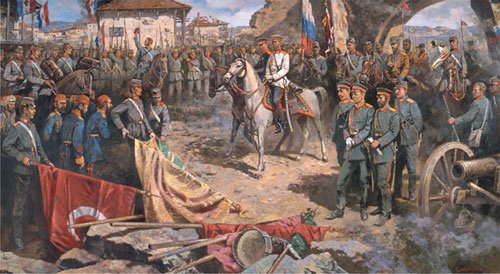The Battle for Pleven

(*)
For five months the battle for Pleven continued, on which the outcome of the entire Liberation War depended.
The Russian command expected to take the city by storm. But both attempts, made in July, failed. To break the resistance of the 44,000-strong Turkish army under the command of Osman Pasha proved to be a difficult task. The command of the Russian army made the right decision to conduct more thorough preparation for a new assault. Changes were made in the location of the troops, fresh forces were brought up, the parts under Pleven were replenished. Secondary liberation of Lovech ensured the rear of the Russian troops. By this time, the Romanian units arrived in time to help the besiegers.
The third assault of Pleven, undertaken in September 1877, was the most fierce, it was, perhaps, the most bloody battle in the entire war. Only the artillery preparation lasted three days. A decisive attack was scheduled for September 11. The whole day continued attacks of Russian and Romanian units. The legendary general Sobolev, whose detachment acted on the left flank, himself set an example for his soldiers, who were attacked on horseback on a white horse. Not for a minute the fighting on the Grivitski positions did not abate. But despite the heroism of the besiegers and their partial successes, the Turks continued to hold their positions.Moreover, taking advantage of the fatigue and heavy losses of the besiegers, on 12 September they went on a counter-offensive. Four enemy attacks were repulsed, but during the fifth Turks managed to seize one of the redoubts lost by them in previous days. Major Gorlatov, who refused to leave Kovanlyk redoubt, was bayoneted by bayonets of brutalized Turks.
The only but significant success achieved during the third assault on Pleven was the capture of the advanced Grivic redoubt. The price of this victory was very high. The losses were about 13 thousand Russians and 3 thousand Romanian soldiers killed and wounded.
Unsuccessful attacks, heavy losses forced the Russian command to change tactics. In late September, a well-known expert of the siege case, the hero of the Sevastopol epic, General Totleben, arrived from St. Petersburg to the location of the Russian troops. Having familiarized himself with the course of the battles, with the situation, he came to the conclusion that the best means of mastering the city is the siege. It was necessary to block all roads leading to Pleven in order to deprive the strengthened Turkish garrison in Pleven of getting reinforcements and delivering food, exhausting its forces and forcing it to surrender.
Under the leadership of Totleben, the planned siege of Pleven began. In the command of the Western detachment, changes were made, the position of the batteries was changed, and a whole system of fortifications was erected. At the end of October, the Turks were forced to surrender to the villages of Horni-Dybnik and Telish.
The wrap around the circle shrank. The situation of the Turkish garrison became critical. On November 30, Osman Pasha decided on a desperate step: gathering all his strength, he tried to break through the encirclement ring.
In the early morning of December 12, Turkish batteries started furious shelling of Russian positions. The Turks went on the attack. But the failures followed one after another. In panic, they recoiled. A white flag was raised over the Turkish positions. The army of Osman Pasha capitulated.
The fall of Pleven marked a turning point in the course of the War of Independence. Turkish troops, exhausted, lost faith in the victory, suffered defeat on all fronts. The Russian army, which had achieved superiority in the forces and military equipment, was moving to Constantinople. The detachment of General Gurko, crossing Stara Planina in the Arabakonak pass, freed Sophia and headed for Pazardzhik and Plovdiv. The detachment of General Radetsky, having defeated the Turkish forces at Shipka, took the entire army of Weisel Pasha in the region of Sheinovo. In the battles of Sheinovo, the Bulgarian militia took an active part.
Congratulating the major victory of the Bulgarian militia, General Sobolev said that they fought no worse than their comrades in arms, the soldiers of the Russian army, which has more than two hundred years of history.
On January 20, Adrianople fell. Ten days later in this city the Turks announced their unconditional surrender. But the offensive of the Russian troops continued. The liberators reached the town of San Stefano, located not far from the Turkish capital. Here, on February 19 (March 3), 1878, a peace treaty was signed.
Very cool post!
This post has received a 0.26 % upvote from @drotto thanks to: @banjo.
nice work :)))